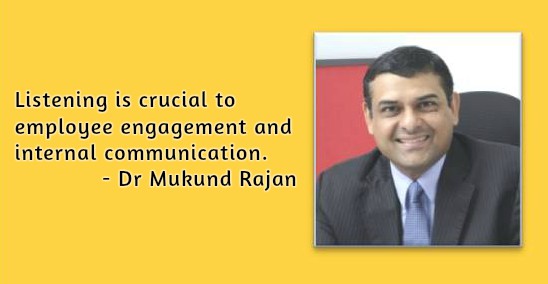Dr Mukund Rajan serves as a Member of the Group Executive Council at Tata Sons Ltd, and is the Tata Brand Custodian. He has served on the boards of various Tata companies, including Tata Teleservices, Tata Communications, Roots Corporation and Piem Hotels. Currently he is a Non-Executive Director on the boards of Lakshmi Machine Works, Tata SIA Airlines and TCS Foundation, and is a member of the Advisory Board of the Tata Opportunities Fund. He is Chairperson of the FICCI Environment Committee and serves as the Co-Chair of the CII National Committee on CSR.
In a conversation with Shree Lahiri, he talks about Tata’s heritage tag, the power of listening and more…
RT: There is a shift taking place from the ‘old school’ and legacy communication tools to new instantaneous communication. How does your company, with its heritage tag, look at employee engagement?
Ans: The ‘heritage’ tag, for the Tata group, is one of the strongest binding factors that unifies our colleagues across a conglomerate as diverse as ours. Our colleagues are inspired by our 15-decade old legacy and value system and how we communicate with our colleagues has evolved over the years. Factors like the changing nature of the employer-employee relationship, the changed expectations of employees and the availability of new channels of communication in the connected workplace have prompted corporates to quickly adapt themselves to this dynamic environment. From a top-down, one-way communication stance, companies and internal communicators are moving to a two-way communication approach, where the employer and employee are equal stakeholders, with both getting a chance to speak and be heard. Internal communicators must create a deeper engagement and involvement with the employees. It’s no different at Tata.
With 600,000+ employees spread across continents, we are conscious that we have an enormous task at hand – of creating a common bond, to invoke a strong sense of belonging and pride in the Tata family, known for its unique heritage, pioneering legacy and reputation for trust and ethical conduct. We are constantly looking at new ways to Engage. Our group intranet allows colleagues across companies to connect with each other and with the Tata brand, share experiences round common themes, like brand marketing, corporate communication, internal audit, and so on. Enabled with social media tools, the intranet brings together our colleagues, empowers them to express themselves and learn from feedback. We’ve also launched mobile apps to enable easier access to the intranet.
RT: “It’s not the consumer’s job to figure out what they want”, said Steve Jobs. How do you think this fits into the sentiment of internal communicators?
Ans: For the internal communicator, the consumer is the employee workforce. Therefore, the treatment and approach to communication and creating and delivering insightful, value-added services, will remain the same as that for any other retail consumer. This would certainly involve developing a deep understanding of the audience’s needs, and identifying the ‘said’ as well as the ‘un-said’ need gaps which would then need to be addressed. Further, ‘listening’ is crucial to employee engagement and internal communication. It helps us understand the sentiment among employees, gives us insights into what gives them satisfaction or causes dissatisfaction at the workplace. Such feedback enables us to engage better, in more meaningful ways with our colleagues.
RT: You need a two-way dialogue for any effective communication. Do you think this is happening today in Internal Communications?
Ans: Yes, I do believe communicators today understand the importance of engaging with their audiences and are increasingly measuring their effectiveness by their ability to elicit a dialogue or discussion around their content. It has to be a reciprocal relationship, with both parties getting a chance to speak and be heard; only then can we expect meaningful outcomes. In fact, a successful engagement goes beyond a two-way dialogue and draws debate and conversation from a wider audience. This is well reflected in the popularity of various engagement metrics, rather than simple reach or impression metrics that are being used to measure the success or failure of a campaign.
RT: Being an effective communicator is impossible without good listening skills. Please comment.
Ans: Communication is a two-way or a multi-way conversation, and therefore, is quite ineffective without the ability to listen and process, and respond appropriately. A good listener will pick up the nuances and the tone of conversation and seize the opportunity to extend the conversation or multiply its engagement through creative responses. Listening also helps communicators to understand and anticipate the needs of their audience, be it internal or external, and not only respond to the situation more effectively but also plan better for future situations.
RT: Employees and other internal audiences are key ambassadors and reaching them today is both challenging and rewarding. Have you come across any challenges?
Ans: Internal audiences are not just our brand ambassadors but – especially in our kind of an organisation – consumers of our products and services. And, happy customers are good for business. However, for audiences today, the stretched demands on their time, coupled with content clutter, imply diminishing attention spans. The challenge therefore, lies in developing engaging, useful content that will break through the clutter, and delivering it in a crisp and concise manner, often enabling the audience to consume it within a minute or less.
RT: Mastering Internal Communication is not only possible but crucial to the success and profitability of an organisation; effective communicators increase profit. How do you see it?
Ans: Internal communication has to be tied to the larger organisational goal. It is an important tool to align employees to the vision, mission and business strategy of the organisation. Employees have to buy into your business goals to help you achieve those goals more efficiently.
Effective communicators would be able to align colleagues towards these goals and convert every employee into a brand ambassador. They transmit and multiply energy and passion across all levels of the organisation, bringing about a visible enhancement of experience when employees interface with customers. When all the employees of an organisation share a unified vision and work towards a common goal, the power of their collective consciousness elevates the purpose and performance of any organisation.






Be the first to comment on "Communicator Speak – Dr Mukund Rajan"